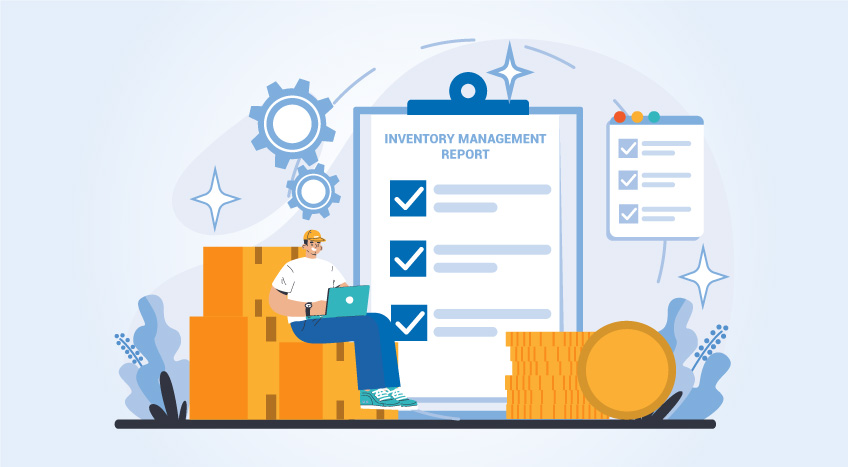- What is inventory control?
- Why is inventory control important for your business?
- How to control your inventory?
- How TallyPrime helps in optimum inventory management?
What is inventory control?
Inventory control is also known as stock control and comprises processes involved in ensuring you have enough product supply to meet customer demand. It includes production and internal control processes that warranty financial elasticity. Its purpose is to generate business profits while investing minimally in stock to satisfy customers. It prevents stockouts that have affected big businesses.
Did you know? In 2014, Walmart lost over $3 million in sales due to stockouts and no provision for inventory control. Controlling inventory is vital for businesses of all sizes and applicable to every industry that is involved in maintaining inventory.
Inventory control and inventory management are not the same. Inventory management is a vast term that encompasses all the processes starting from procurement to profit generation. The control of inventory, on the other hand, is a subset of inventory management as it mainly deals with the products and items stored in the warehouse. For this reason, warehouse management is also a part of inventory control. Supply chain management (SCM) is a major part of controlling inventory as it involves managing the movement of raw materials until the goods are sold to the consumers.
Why is inventory control important for your business?
Improved quality
Inventory control enables you to improve your product quality and ensure that quality standards are maintained. Quality control is a vital aspect of every product as your consumers will turn to your competitors if their quality expectations are not met. Inventory controlling processes enable you to track every stock and manage it in all possible ways.
You know when you should sell a particular product if it is a perishable good and needs to be sold by a certain date. The longer the products stay at your warehouse, the more chances they have of getting damaged. Moreover, you can thoroughly evaluate the stock quality from suppliers and make changes if you are unhappy with the results.
Higher inventory accuracy
Inventory accuracy is vitalfor inventory management and proper inventory control ensures complete precision. Inventory accuracy is useful at the time of audit because it will make the process go smoother and quicker. If you have redundant inventory data, you will have to re-count which makes the process stretch for a longer time.
Redundant inventory data is also likely to be full of errors. When you have inventory under control, you will know exactly how much you have and the time you have to sell it to your consumers before they are damaged due to an approaching expiry date or other factors.
Increased savings
Inventory control increases your business savings as it cuts down the overhead costs. If you do not have a basis for understanding your inventory, you cannot measure your inventory and cannot find where the problems occur. This will prevent you from utilizing your inventory to the fullest.
When you have processes to control inventory in place, you know which type of inventory to hold and how much thereby preventing all these problems. You will also reduce the overhead costs of storage and prevent spoilage costs as you know when the stock needs to move and be sold.
Better organization control
Inventory control promotes organizational control because you can improve management. You know exactly how long it will take for you to get the stock when it is in high demand thereby improving customer satisfaction and leading to better sales and better business.
If you sell seasonal merchandise, you know when there will be a peak in demand and when the sales will dry up. You can shift your marketing focus accordingly and get stock that is sufficient for on and off seasons. This allows you to prevent dead stock which is simply stock that doesn’t sell.
Enhanced customer satisfaction
Inventory control enhances your business processes and ultimately leads to an increase in customer satisfaction. Customer expectations have changed, and they continue to evolve, as they expect faster delivery times and proper quality products.
When you have strategies to control inventory, you will ensure your website reflects exactly how much stock you have at hand so you aren’t making fake promises mistakenly. Several studies have shown that customers stop doing business with a brand because of stockouts. By controlling your inventory, your customers trust your business because you provide reliable services.
How to control your inventory?
Thorough inventory control plan
Controlling your inventory must start with a good and reliable plan. The plan is not set in stone and you must regularly update it to ensure it reflects the current scenario of your inventory in the warehouse. Execution before the planning aspect is futile because it can cause problems to crop up in the future.
Dedicate time to creating a plan
Instead, take time out of your schedule to create a control plan and include all those people who are aware of the inventory processes. This will allow everyone to contribute to the plan and ensure it is thorough. The plan should include various aspects such as how you plan on measuring your stock in the warehouse.
What should the control plan contain?
The control plan should also reflect any upcoming events that can affect stock availability and thereby affect production. This allows you to be better prepared for any shortages and plan to mitigate any major problems.
The plan should also include the cycle and movement of your stock on a general basis so you are aware of how you expect it to reach your customers timely after they place an order. It should also include how you will utilize space available in your warehouses to ensure proper warehouse management.
Robust inventory management software
Inventory management software is a must for inventory control because it ensures errors are minimized through proper automation. Although you can get an inventory control system, it will be limited to the control processes only. If you want the best of both worlds, you must opt for an inventory management software system such as TallyPrime for efficient inventory management.
A scalable system is a better option because your business will grow in due course and your need for advanced features will increase as time goes by. An inventory management system with proper security features is key to ensure only those who require access have it.
Inventory management software benefits
Inventory management software is excellent when you want to automate, set alerts, and generate reports for proper planning and execution to fulfill orders. Generation of reports is essential because it reveals the stock use and how long the stock is staying at each warehouse. It also shows how much stock is available and enables you to set alerts to restock the essential items when required so you are never out of stock.
Have a backup
Despite having a software tool, it is best to have a backup plan in case of outages that can affect your operations. Inventory software also enables you to understand how much you are spending on inventory and where you can cut costs.
Balance inventory costs and have sufficient stock on hand
Small businesses often fail because they cannot control inventory costs that keep piling up due to poor warehouse and inventory control. Every business must find ways to reduce obsolete and dead stock. One way to reduce inventory costs is to make use of inventory reports generated from an inventory management software system.
Reports are vital for understanding cost and stock
The reports show which items have a short life and must be sold immediately and which items can be sold at a later date. When you control inventory through reliable methods such as using software and planning inventory, you will keep costs low.
Avoid understocking
While every business wants to keep costs low, you must not achieve it by understocking because it will impact customer satisfaction. Instead, you must determine how much stock is expected to be sold and then plan to have that much stock in hand.
Use ratios
You can use a range of ratios to determine how much stock you need to ideally have at hand to meet demand. You must find the balance between storing the product and preventing stockouts in your warehouses. You must ensure you always have critical stock at hand so your business doesn’t suffer.
Manage supplier relationships
Managing supplier relationships is an important aspect of inventory control. You want to continue to do business with suppliers that you trust and who can send you goods on short notice if ever an emergency occurs. You want to continually assess your relationship with your suppliers and see how you can improve it.
Better relationship means more benefits
Mutual trust and respect will lead to discounts and other benefits for you when you purchase from your supplier in bulk. It can also mean better terms. It is best to have a contract in place for clarity and legal purposes so both of you are aware of your expectations of each other.
Benefits of supplier relationship management
Supplier relationship management ensures you can set your product prices competitively and have a better profit margin. You can also get a competitive edge over your competitors in the same industry due to the advantages present. It helps you with better risk management as your supplier is more likely to help you in a crisis when you have maintained a good relationship with him.
As your needs evolve, your suppliers will grow with you and be able to provide the type of advanced service you need. Maintaining good relationships by being honest and straightforward is necessary for proper inventory control.
Use ABC analysis
ABC analysis groups the inventory you have on hand into three categories; A, B, and C. The ‘A’ group items are valued the highest and have lower sales. The ‘B’ group items have a higher value than the ‘C’ group items but a lower value than the ‘A’ group items. The ‘C’ group items have the least value in comparison to the other two groups while they are sold the most by your business.
You need to separate your inventory into these three groups so you know how many distinct products you have in each. Then you can put your focus on selling more of the high-value items to your customers while maintaining the sale of the other two categories.
Categorize further for easier segregation
You can also store your items based on their demand and their categories making them easy to find when you need to fulfill customer orders. This makes it easy to keep track of inventory for easy retrieval. When you perform ABC analysis, you get to identify and classify inventory for better inventory management.
If you look at inventory from one viewpoint, you may be missing out on selling the high-value inventory. Through regular analysis, you can segregate your inventory and sell all types of different stocks you have at hand.
Inventory control vs. inventory management
Inventory control and inventory management are two distinct terms that are often confused with being the same. They cannot be used interchangeably because their functions and capacities differ even though they serve similar purposes.
|
Inventory control |
Inventory management |
|
Inventory control is a portion of inventory management and it deals with stock management in the warehouse.
It involves a range of activities including the receiving, storage, and transfer of stocks. It also involves tracking orders placed by customers and fulfilling those orders.
If returns are made, inventory control ensures that happens without any issues too. |
Inventory management is a broad management feature that includes inventory control. It includes ordering stock, storing it properly, and using it for the best results.
It involves dealing with all the inventory-related processes starting from gathering the raw materials to making the finished products and selling them to customers. Inventory management reveals stock order questions; what, when, and how much. |
|
Inventory control defines the stock flow which determines the rate at which your stock moves in your business.
It answers questions such as how much stock is required to fulfill current customer orders and when they must be at the warehouse for the entire process to run smoothly.
The focus of inventory control is always on the relationship between the stock in the warehouse and your customers. |
Inventory management is a much more complex process as it involves processes such as procuring raw materials and ensuring the finished products reach your customers timely.
It tracks the product lifecycle and ensures every minute detail is taken care of when a customer places an order.
It ensures a balance is maintained between having sufficient stock at hand and preventing wastage by overstocking. |
|
Inventory control elements include tracking stock in a warehouse and ensuring the stock in the warehouse is safe and in good condition.
Businesses need to ensure the items are sold before the expiration date arrives by either selling the goods in bundles or ensuring the raw materials are used to make the finished goods before they spoil.
It also includes keeping the high-demand items closer to the packaging areas for faster order fulfillment rates to improve customer satisfaction. |
Inventory management elements include ensuring the stock is managed from the time it is ordered by a customer until it reaches the customer.
It involves understanding when to restock items and in what quantities, tracking stock movement, and forecasting customer demand for better stock management.
It helps a business grow by ensuring audits are regularly performed to verify inventory counts. |
|
Inventory control leads to happier customers because customers want quality products and timely product delivery.
When you have proper control processes in place, you know you are showing more stock than is available thereby giving your customers a realistic view of how much stock you have at hand.
Inventory control also reduces storage costs, prevents inventory damage, and decreases obsolete inventory. |
Inventory management is highly beneficial to every business because it takes care of a wide range of inventory aspects for better growth.
It ensures you don’t have too much inventory in hand thereby reducing overhead costs. It also ensures proper order fulfillment is in place thereby ensuring satisfied customers.
Inventory management also helps in making wise investment decisions so you make a profit and don’t buy stock unnecessarily. |
|
An inventory control system has features such as inventory tracking, auditing, reporting, check-in and check-out, and notifications so you are aware of the stock situation at any given time.
It can track the stock condition and manage expiry dates so you know when to sell the stock before it spoils.
It also involves generating reports that help with better inventory management. |
An inventory management system has features such as inventory auditing, forecasting, reporting, planning, optimization, and order management.
The system helps in demand prediction and planning how much stock to keep at hand at any given time based on past data and trends.
It also includes processes that ensure the proper stock movement such as from the warehouse to where they need to be delivered. |
How TallyPrime helps in optimum inventory management?
TallyPrime is a flexible inventory control and management system that ensures your business can attain and maintain optimum inventory levels at all times. Here are some of the top features that make it stand a class apart from the other inventory management systems available.
- TallyPrime handles exceptions with ease making you perform your business operations with such ease that will only make you wonder why you didn’t get this robust inventory management software before.
- It generates a range of inventory reports such as stock summary, item-wise profitability, and aging analysis that give you insights on stock movement to make informed decisions. These can be used to cut costs across your inventory operations and improve efficiency.
- The software enables you to define batches, warehouses, categories, and groups at your convenience for better management in a way that makes the most sense for your business. This versatility makes it a good fit for a range of businesses.
- It has a manufacture and expiry date management feature that tells you what product needs to be sold before the expiry date and how many days until the expiry date. This makes it simpler to manage inventory and sell it to prevent dead stock.
- It lets you utilize a range of stock valuation methods such as average cost, FIFO, LIFO annual, at zero cost, and LIFO perpetual for better inventory management. This can be done at an item-based level for more clarity.
- To manage inventory, you need to know the job and material status. TallyPrime provides you with this feature that gives you better visibility into your job work by allowing you to record the consumption of materials, receipts, and much more.
- You can set a re-order level and minimum order level to always have sufficient stock on hand to meet customer demand. You can easily generate a re-order status report to understand the quantities you need to order and when.
- TallyPrime’s job costing feature enables you to track the costs and revenues required to get each task completed. Whether it is overhead costs, material costs, or labor costs, you can get a thorough understanding of each.
TallyPrime is a complete business management software that comes with other useful features such as payroll processing, features, banking facilities, and cash flow management.
Read More:
- Best Inventory Management Software for Small Businesses
- A Complete Business Management Software for Your Business In USA
Explore More Products










